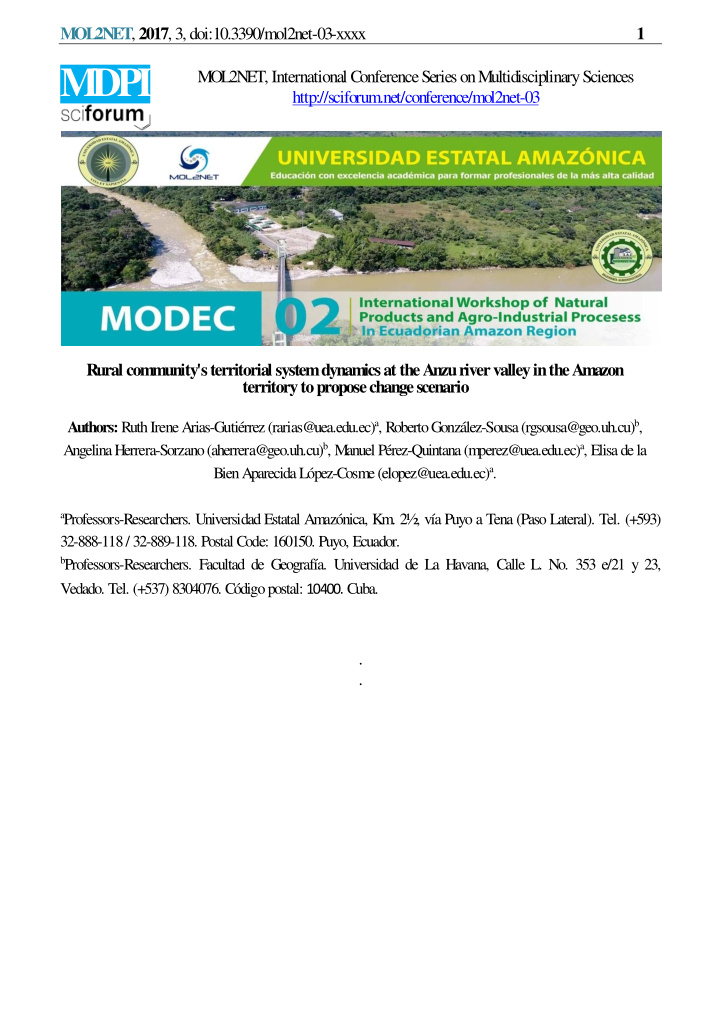



M OL2NET , 2017 , 3, doi:10.3390/mol2net-03-xxxx 1 M DPI MOL2NET, International Conference Series on Multidisciplinary Sciences http://sciforum.net/conference/mol2net-03 Rural community's territorial system dynamics at the Anzu river valley in the Amazon territory to propose change scenario Authors: Ruth Irene Arias-Gutiérrez (rarias@uea.edu.ec) a , Roberto González-Sousa (rgsousa@geo.uh.cu) b , Angelina Herrera-Sorzano (aherrera@geo.uh.cu) b , M anuel Pérez-Quintana (mperez@uea.edu.ec) a , Elisa de la Bien Aparecida López-Cosme (elopez@uea.edu.ec) a . a Professors-Researchers. Universidad Estatal Amazónica, Km. 2½, vía Puyo a Tena (Paso Lateral). Tel. (+593) 32-888-118 / 32-889-118. Postal Code: 160150. Puyo, Ecuador. b Professors-Researchers. Facultad de Geografía. Universidad de La Havana, Calle L. No. 353 e/21 y 23, Vedado. Tel. (+537) 8304076. Código postal: 10400. Cuba. . .
M OL2NET , 2017 , 3, doi:10.3390/mol2net-03-xxxx 2 Graphical Abstract Abstract. A Kichwa community’s dynamics at the river Kichw a com m unity’s Anzu valley, in the Ecuadorian Amazon territory, to propose change scenarios is analyzed. The Anzu valley, populated by sustainable mestizos and Kichwa communities, autonomous, in harmony with nature, visible in the different products that they process from environm ent resources, live in their legalized territories, where government entities recognized M estizos and Kichw a the Kichwa ancestral property. The Kichwa achieved to articulate strategies for the biodiversity resources use, whose beneficial repopulation and processing may allowed obtaining their m aintenances, the paym ent of their labor and income fam ilies. The knowledge system and the people’s cultural identity in social harmony with nature are revalued. The Jungle and anim al protection territory possession and its security, together with the ancestral knowledge, managem ent system s understanding of the environm ent resources, which come from a cultural tradition, wisdom in the jungle associated with new technological forms that provide econom ic income through the local resources processing, gives com munities the opportunity to renew their pride, which contributes to the consistent Alliances and synergies use of their environment. It recovers and intensifies the agro ecosystem managem ent, gradually increases the promissory species sowing and repopulation, anim als and plants. The desired scenario implies a sustainable, autonomous functioning, with alliances and synergies. Keywords: Kichwa com munities, Amazon territorial systems, sustainability. Introduction In the world, indigenous peoples have lived on the nature products, many peoples migrate when the area resources are depleted, until the natural environment is regenerated and can be used again. Indigenous peoples' livelihoods are altered by processes related to development, political decisions, natural resources exploitation, m ining, urbanization, modernization, infrastructure development,
M OL2NET , 2017 , 3, doi:10.3390/mol2net-03-xxxx 3 clim ate change and global warming (Dublin & Tanaka, 2014; Akerlof et al ., 2010). As a plurinational- intercultural rights & justice State, Ecuador is made up of 15 original nations or indigenous nationalities, as well as Afro-Ecuadorian populations, montuvias (peasants from the coastal region), white and mestizo people (Constitución de la República del Ecuador, 2008). There is now an international trend towards the indigenous people’s collective rights recognition, whose main claim s are the land recovery from which they were dispossessed; the collective rights to own, develop, use, control and occupy their lands and traditional resources involve the integrity and conservation of their natural habitat, including environmental protection. Som e Latin American countries have made significant progress in this regard, through constitutionally recognizing the indigenous people ’ s legal personality, which has not been possible in other countries. The right to respect, integrity and conservation of habitats and natural resources are closely linked to the indigenous peoples and environmental protection (Gaona, 2013). The Amazon western portion, including Ecuador, is one of the most bio diverse areas on the planet, home to several indigenous peoples, it maintains intact portions of jungle and it has a high probability of stabilizing climate conditions face to global warm ing problems (Smith & Leiserowitz, 2014; Gainette, 2009). In the present evolution analysis researching from Am azon com munity’s development and its consequences in the Ecuadorian Amazonian territory, it is contextualizing the original indigenous nation territory of Ecuadorian Amazonian Kichwa and the conceptualizing of the change scenarios pertinence. The aim was to analyze a Kichwa com munity’s dynam ics at the river Anzu valley, in the Ecuadorian Amazon territory. M aterials and M ethods Six communities located in the ancestral territory of the original Ecuadorian Kichwa Amazonian nation are studied, from Northeaster Tzawata, until the Southwester Veinticuatro de Mayo com munities (table 1), located in the low, medium and high levels of the Anzu River valley; the communities settled since the end of the 19th century, come from the Napo province. They are rural com munities, representative of a common origin and express a vulnerability gap in relation to the initiatives developed by the local governments and the planning units. Table 1. Location of selected communities in the study. Z a Altitude North Community East Parish Canton Province Tzawata 18 508 9 869 264 179 523 Carlos Julio Carlos Julio Napo Arosemena Arosemena Wayuri 17 1200 9 862 500 831 306 Mera Mera Pastaza Flor de Bosque 18 752 9 858 789 170 876 Santa Clara Santa Clara Pastaza Boayaku 18 808 9 854 478 168 082 Teniente Hugo Ortiz Pastaza Pastaza Unión de Llandia 18 1099 9 851 931 169 383 Teniente Hugo Ortiz Pastaza Pastaza Veinticuatro de 17 994 9 845 509 832 473 Fátima Pastaza Pastaza Mayo a Universal Transverse Mercator South zone The studied communities are located from 508 to 1 200 meter over sea level, in the eastern foothills of the central Andes, south of the sub-Andean zone identified as Napo Uprising; on hydromorphic alluvial soils with a forest vocation, volcanic origin and conservation purposes; soils formed by the dejection cones in the Amazon foothills, as a result of the fusion of plio-quaternary glaciers and volcanic and seismic activity (Senplades; Instituto Geográfico Militar, 2010). Rainfall is never less
Recommend
More recommend